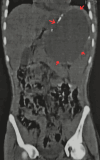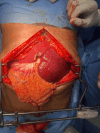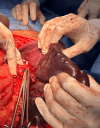Post-traumatic Pseudocyst of the Spleen: A Report of a Rare Case
- PMID: 40385911
- PMCID: PMC12083853
- DOI: 10.7759/cureus.82386
Post-traumatic Pseudocyst of the Spleen: A Report of a Rare Case
Abstract
Splenic pseudocysts are multifactorial in etiology, with trauma being the most common causative factor, wherein an intrasplenic hematoma forms and subsequently liquefies. They can also develop as a result of infections - both local and systemic - through an inflammatory process and tissue necrosis. Pancreatitis-induced splenic pseudocysts, although exceedingly rare, arise either from the direct extension of pancreatic inflammation, enzymatic autodigestion of the pancreas, or the close anatomical relationship between the pancreas and spleen. Splenic pseudocysts are diagnosed by demonstrating their size, location, and internal septations or calcifications on imaging modalities such as computed tomography (CT) and magnetic resonance imaging. Although less sensitive than CT at discerning subtle details, ultrasonography plays a major role in initial and longitudinal monitoring, particularly due to its lack of radiation exposure, which is beneficial for certain patient populations, including pregnant or pediatric patients.
Keywords: road traffic injuries; splenic pseudocyst; splenic trauma; subcapsular splenic hematoma; total splenectomy; traumatic splenic rupture.
Copyright © 2025, Kumar et al.
Conflict of interest statement
Human subjects: Consent for treatment and open access publication was obtained or waived by all participants in this study. Conflicts of interest: In compliance with the ICMJE uniform disclosure form, all authors declare the following: Payment/services info: All authors have declared that no financial support was received from any organization for the submitted work. Financial relationships: All authors have declared that they have no financial relationships at present or within the previous three years with any organizations that might have an interest in the submitted work. Other relationships: All authors have declared that there are no other relationships or activities that could appear to have influenced the submitted work.
Figures





References
-
- Treatment of pancreatic pseudocysts. Andrén-Sandberg A, Ansorge C, Eiriksson K, Glomsaker T, Maleckas A. Scand J Surg. 2005;94:165–175. - PubMed
-
- Czarniecki M, Niknejad M, Fahrenhorst-Jones T. Radiopaedia; 2025. Splenic Pseudocyst.
-
- Huge epithelial nonparasitic splenic cyst: a case report and a review of treatment methods. Farhangi B, Farhangi A, Firouzjahi A, Jahed B. http://pubmed.ncbi.nlm.nih.gov/27386069/ Caspian J Intern Med. 2016;7:146–149. - PMC - PubMed
Publication types
LinkOut - more resources
Full Text Sources
